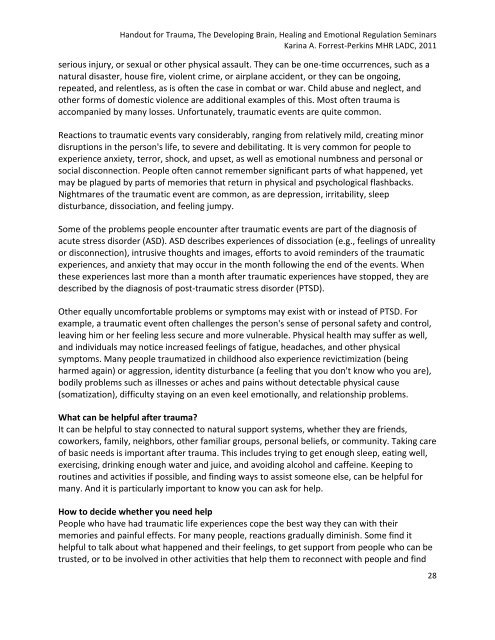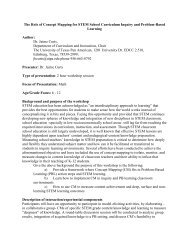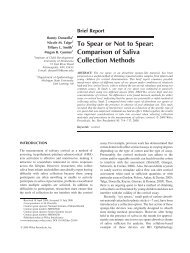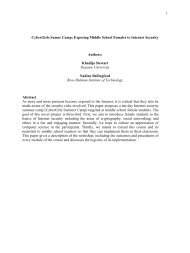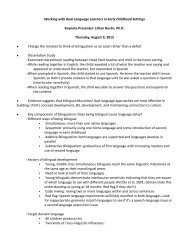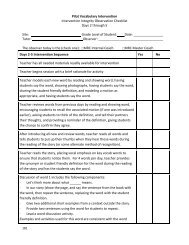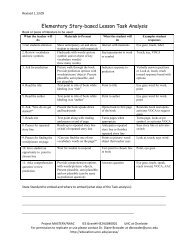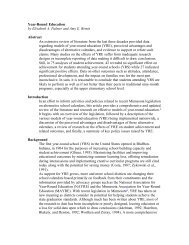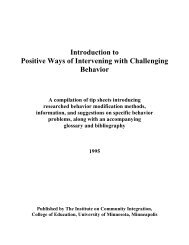Trauma and the Developing Brain - College of Education & Human ...
Trauma and the Developing Brain - College of Education & Human ...
Trauma and the Developing Brain - College of Education & Human ...
Create successful ePaper yourself
Turn your PDF publications into a flip-book with our unique Google optimized e-Paper software.
H<strong>and</strong>out for <strong>Trauma</strong>, The <strong>Developing</strong> <strong>Brain</strong>, Healing <strong>and</strong> Emotional Regulation Seminars<br />
Karina A. Forrest-‐Perkins MHR LADC, 2011<br />
serious injury, or sexual or o<strong>the</strong>r physical assault. They can be one-‐time occurrences, such as a<br />
natural disaster, house fire, violent crime, or airplane accident, or <strong>the</strong>y can be ongoing,<br />
repeated, <strong>and</strong> relentless, as is <strong>of</strong>ten <strong>the</strong> case in combat or war. Child abuse <strong>and</strong> neglect, <strong>and</strong><br />
o<strong>the</strong>r forms <strong>of</strong> domestic violence are additional examples <strong>of</strong> this. Most <strong>of</strong>ten trauma is<br />
accompanied by many losses. Unfortunately, traumatic events are quite common.<br />
Reactions to traumatic events vary considerably, ranging from relatively mild, creating minor<br />
disruptions in <strong>the</strong> person's life, to severe <strong>and</strong> debilitating. It is very common for people to<br />
experience anxiety, terror, shock, <strong>and</strong> upset, as well as emotional numbness <strong>and</strong> personal or<br />
social disconnection. People <strong>of</strong>ten cannot remember significant parts <strong>of</strong> what happened, yet<br />
may be plagued by parts <strong>of</strong> memories that return in physical <strong>and</strong> psychological flashbacks.<br />
Nightmares <strong>of</strong> <strong>the</strong> traumatic event are common, as are depression, irritability, sleep<br />
disturbance, dissociation, <strong>and</strong> feeling jumpy.<br />
Some <strong>of</strong> <strong>the</strong> problems people encounter after traumatic events are part <strong>of</strong> <strong>the</strong> diagnosis <strong>of</strong><br />
acute stress disorder (ASD). ASD describes experiences <strong>of</strong> dissociation (e.g., feelings <strong>of</strong> unreality<br />
or disconnection), intrusive thoughts <strong>and</strong> images, efforts to avoid reminders <strong>of</strong> <strong>the</strong> traumatic<br />
experiences, <strong>and</strong> anxiety that may occur in <strong>the</strong> month following <strong>the</strong> end <strong>of</strong> <strong>the</strong> events. When<br />
<strong>the</strong>se experiences last more than a month after traumatic experiences have stopped, <strong>the</strong>y are<br />
described by <strong>the</strong> diagnosis <strong>of</strong> post-‐traumatic stress disorder (PTSD).<br />
O<strong>the</strong>r equally uncomfortable problems or symptoms may exist with or instead <strong>of</strong> PTSD. For<br />
example, a traumatic event <strong>of</strong>ten challenges <strong>the</strong> person's sense <strong>of</strong> personal safety <strong>and</strong> control,<br />
leaving him or her feeling less secure <strong>and</strong> more vulnerable. Physical health may suffer as well,<br />
<strong>and</strong> individuals may notice increased feelings <strong>of</strong> fatigue, headaches, <strong>and</strong> o<strong>the</strong>r physical<br />
symptoms. Many people traumatized in childhood also experience revictimization (being<br />
harmed again) or aggression, identity disturbance (a feeling that you don't know who you are),<br />
bodily problems such as illnesses or aches <strong>and</strong> pains without detectable physical cause<br />
(somatization), difficulty staying on an even keel emotionally, <strong>and</strong> relationship problems.<br />
What can be helpful after trauma?<br />
It can be helpful to stay connected to natural support systems, whe<strong>the</strong>r <strong>the</strong>y are friends,<br />
coworkers, family, neighbors, o<strong>the</strong>r familiar groups, personal beliefs, or community. Taking care<br />
<strong>of</strong> basic needs is important after trauma. This includes trying to get enough sleep, eating well,<br />
exercising, drinking enough water <strong>and</strong> juice, <strong>and</strong> avoiding alcohol <strong>and</strong> caffeine. Keeping to<br />
routines <strong>and</strong> activities if possible, <strong>and</strong> finding ways to assist someone else, can be helpful for<br />
many. And it is particularly important to know you can ask for help.<br />
How to decide whe<strong>the</strong>r you need help<br />
People who have had traumatic life experiences cope <strong>the</strong> best way <strong>the</strong>y can with <strong>the</strong>ir<br />
memories <strong>and</strong> painful effects. For many people, reactions gradually diminish. Some find it<br />
helpful to talk about what happened <strong>and</strong> <strong>the</strong>ir feelings, to get support from people who can be<br />
trusted, or to be involved in o<strong>the</strong>r activities that help <strong>the</strong>m to reconnect with people <strong>and</strong> find<br />
28


